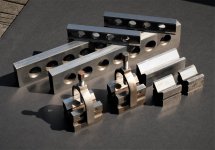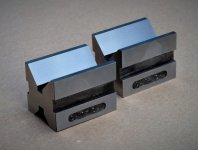Hi Conrad:
You have a couple of problems to overcome to make these as accurate as possible.
Since you don't have an accurate sine plate to help you , here's how I would go about it.
First I'd grind the ends of both blocks flat and parallel so I can clamp them accurately in the vise.
Next I'd rough grind the sides, top and bottom leaving some stock for later.
Third, I'd tip them up in the vise on 45 degrees pinching them on the ground ends and tramming them in using an indicator and the "rise over run" method of determining when they're accurately tilted.
Next I'd grind the vees, rough sidewheeling the vertical flank and finish conventional grinding the horizontal flank but plunging down at the beginning of the traverse and then traversing away from the junction of the vee to eliminate wheel wear on the flat surface near the root of the vee.
Without removing the part from the vise I'd flip the vise on its side and finish grind the second side of the vee with the bottom of the wheel using the same plunge and traverse method.
I'd pay no attention to how well it was centered at this point; that can come later.
Once the vee surfaces are done, I'd drop in a gauge pin and clock over both ends on a surface plate, then grind the bottom perfectly parallel to the vee, then grind the top parallel to the bottom.
To check how close I got the angle, the best way I've found is to make a 45 x 45 x 90 prism out of a scrap piece, grind the two 90 degree legs accurately square then drop it into the vee and surface grind the hypotenuse.
Flip it around and clock it on the surface plate; the deviation across the hypotenuse will of course be twice the error of the angle.
Correct that by lapping or grinding and then deal with the sides.
Clock in a bar clamped in the vee with the block laying down sideways then set it parallel and kiss the side face.
Flip the block and grind the second side parallel, then measure the amount that needs to come off the high side to get the vee centered in the block and grind that away.
Last check and re-grind the ends orthogonal to the axis of the vees.
Check everything for squareness and parallelism then correct as needed by lapping.
That's it; simple really but a lot of quite fussy work if you want them really accurate, so expect to spend some quality time with them.
Or you can use them for rough stuff as others have suggested, and go to someone like Suburban Tool and get some proper blocks...pricey but still cheaper than rolling your own unless you're willing to work cheap!!

When you do, get the kind with the clamps that are fastened from the top, not those stupid Starrett style that don't let you flip the blocks sideways.
(Sorry, pet peeve of mine!!)
Cheers
Marcus
Implant Mechanix • Design & Innovation > HOME
www.vancouverwireedm.com



